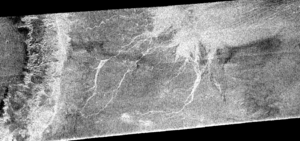Elivagar Flumina
Appearance

Elivagar Fluminais a network ofriverchannels (termedflumina,plural forflumen) ranging from 23 km to 210 km in length[1]in the region around theMenrva CraterofTitan.[2]The channel system is at least 120 km wide and shows signs of erosion. At its mouth, analluvial fanis present.[3]The Elivagar Flumina is interpreted as alluvial due to its closeness to fluvial valleys and as understood from the radar backscatter.[4]Geomorphologic mapping of the Menrva region of Titan has yielded evidence for exogenic processes such as hydrocarbon fluid channelization (in other words flash floods) that are thought to have formed the Flumina network.[2][5]
The Elivagar Flumina is named after theÉlivágar,a group of poisonous ice rivers inNorse mythology.[6]
References[edit]
- ^"Fig. 1. Cassini RADAR image of Menrva and Elivagar Flumina taken during the T3 fly-by, showing the channels near Menrva and the catchment basin (highlighted in blue)".Retrieved18 June2016.
- ^abWilliams, David; Radebaugh, Jani; Lopes, Rosaly; Stofan, Ellen (2011). "Geomorphologic mapping of the Menrva region of Titan using Cassini RADAR data".Icarus.212(2): 744–750.Bibcode:2011Icar..212..744W.doi:10.1016/j.icarus.2011.01.014.
- ^"ALLUVIAL FANS ON TITAN REVEAL MATERIALS, PROCESSES AND REGIONAL CONDITIONS"(PDF).2013.Retrieved18 June2016.
- ^Ingo Müller-Wodarg; Caitlin A. Griffith; Emmanuel Lellouch, 2014. Titan: Interior, Surface, Atmosphere, and Space Environment. Cambridge University Press. p. 69.ISBN978-0-521-19992-6.
- ^Williams, David A., et al. "Geomorphologic mapping of the Menrva region of Titan using Cassini RADAR data." Icarus212.2 (2011): 744-750.
- ^Robert Brown; Jean Pierre Lebreton; Hunter Waite, 2009. Titan from Cassini-Huygens. Springer Science & Business Media. p. 508.ISBN978-1-4020-9215-2.

